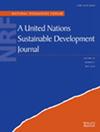揭示健康动态:探索二氧化碳排放、城市化和可再生能源对南亚区域合作联盟国家预期寿命和婴儿死亡率的影响(1990-2022 年)
IF 3.5
4区 社会学
Q2 ENVIRONMENTAL SCIENCES
引用次数: 0
摘要
本研究探讨了能源和现代城市化导致的二氧化碳排放量增加对公众健康造成的日益严重的威胁。为此,我们重点研究了 1990 年至 2022 年南亚区域合作联盟(SAARC)国家的情况。研究探讨了城市化、二氧化碳排放、可再生能源和主要健康指标(即预期寿命和婴儿死亡率)之间的动态关联。研究强调了南亚区域合作联盟(SAARC)经济体应对与二氧化碳排放和城市发展相关的健康挑战所需的可持续政策,从而提供了细致入微的见解。为实现研究目标,作者利用面板自回归分布滞后法评估短期和长期效应,并利用矩量回归法检查不同量级的效应。实证结果强调了可再生能源、城市化、国内生产总值和工业化对预期寿命的积极影响。相反,二氧化碳排放对预期寿命有不利影响,在短期和长期内会导致多种疾病。值得注意的是,在婴儿死亡率方面,研究显示,可再生能源、城市化、国内生产总值和工业化对婴儿死亡率有负面影响,而二氧化碳排放则在短期和长期情况下对婴儿死亡率有正面影响。完全修正的普通最小二乘法和动态普通最小二乘法进一步强化了我们的研究结果,支持了面板自回归分布滞后法和矩量回归法得出的结果。本研究的政策含义强调,政府和决策者必须优先考虑可再生能源和可持续城市化,减轻不可再生能源排放的二氧化碳对健康的不利影响。研究结果进一步支持向可再生能源的战略转变,将其定位为化石燃料等传统能源的替代品。此外,重点还放在有计划和可持续的城市化上,以促进更好地利用卫生设施和整体公共卫生。本文章由计算机程序翻译,如有差异,请以英文原文为准。
Unveiling health dynamics: Exploring the impact of CO2 emissions, urbanization, and renewable energy on life expectancy and infant mortality in SAARC countries (1990–2022)
This study examines the intensifying threat to public health caused by increased CO2 emissions from energy and modern urbanization. In this connection, we focused on SAARC countries from 1990 to 2022. The study explores the dynamic association among urbanization, CO2 emissions, renewable energy, and key health indicators, namely life expectancy and infant mortality. It offers nuanced insights by highlighting the requirement for sustainable policies to meet health challenges associated with CO2 emissions and urban development in SAARC economies. To achieve the study objectives, the authors utilized panel auto regressive distributed lag for assessing short‐term and long‐run effects, and the method of moments quantile regressions to check these effects across different quantiles. The empirical results underscore the positive impact of renewable energy, urbanization, GDP, and industrialization on life expectancy. Conversely, CO2 emissions exhibit a detrimental impact on life expectancy, leading towards numerous diseases in both the short and long term. Notably, in the case of infant mortality, the study discloses that renewable energy, urbanization, GDP, and industrialization negatively affect infant mortality, while CO2 emissions positively impact infant mortality in both short and long‐run scenarios. Fully modified ordinary least squares and dynamic ordinary least squares further fortified our findings, supporting the results derived from panel auto regressive distributed lag and method of moments quantile regressions. The study's policy implications highlight the imperative for governments and policymakers to prioritize renewable energy and sustainable urbanization, mitigating the adverse health effects of CO2 emissions from non‐renewable energy sources. The study's findings further endorse a strategic shift towards renewable energy sources, positioning them as substitutes for conventional forms such as fossil fuels. Additionally, the emphasis is on planned and sustainable urbanization, facilitating improved access to health facilities and overall public health.
求助全文
通过发布文献求助,成功后即可免费获取论文全文。
去求助
来源期刊

Natural Resources Forum
环境科学-环境科学
CiteScore
6.10
自引率
0.00%
发文量
24
审稿时长
>36 weeks
期刊介绍:
Natural Resources Forum, a United Nations Sustainable Development Journal, focuses on international, multidisciplinary issues related to sustainable development, with an emphasis on developing countries. The journal seeks to address gaps in current knowledge and stimulate policy discussions on the most critical issues associated with the sustainable development agenda, by promoting research that integrates the social, economic, and environmental dimensions of sustainable development. Contributions that inform the global policy debate through pragmatic lessons learned from experience at the local, national, and global levels are encouraged.
The Journal considers articles written on all topics relevant to sustainable development. In addition, it dedicates series, issues and special sections to specific themes that are relevant to the current discussions of the United Nations Commission on Sustainable Development (CSD). Articles must be based on original research and must be relevant to policy-making.
Criteria for selection of submitted articles include:
1) Relevance and importance of the topic discussed to sustainable development in general, both in terms of policy impacts and gaps in current knowledge being addressed by the article;
2) Treatment of the topic that incorporates social, economic and environmental aspects of sustainable development, rather than focusing purely on sectoral and/or technical aspects;
3) Articles must contain original applied material drawn from concrete projects, policy implementation, or literature reviews; purely theoretical papers are not entertained.
 求助内容:
求助内容: 应助结果提醒方式:
应助结果提醒方式:


